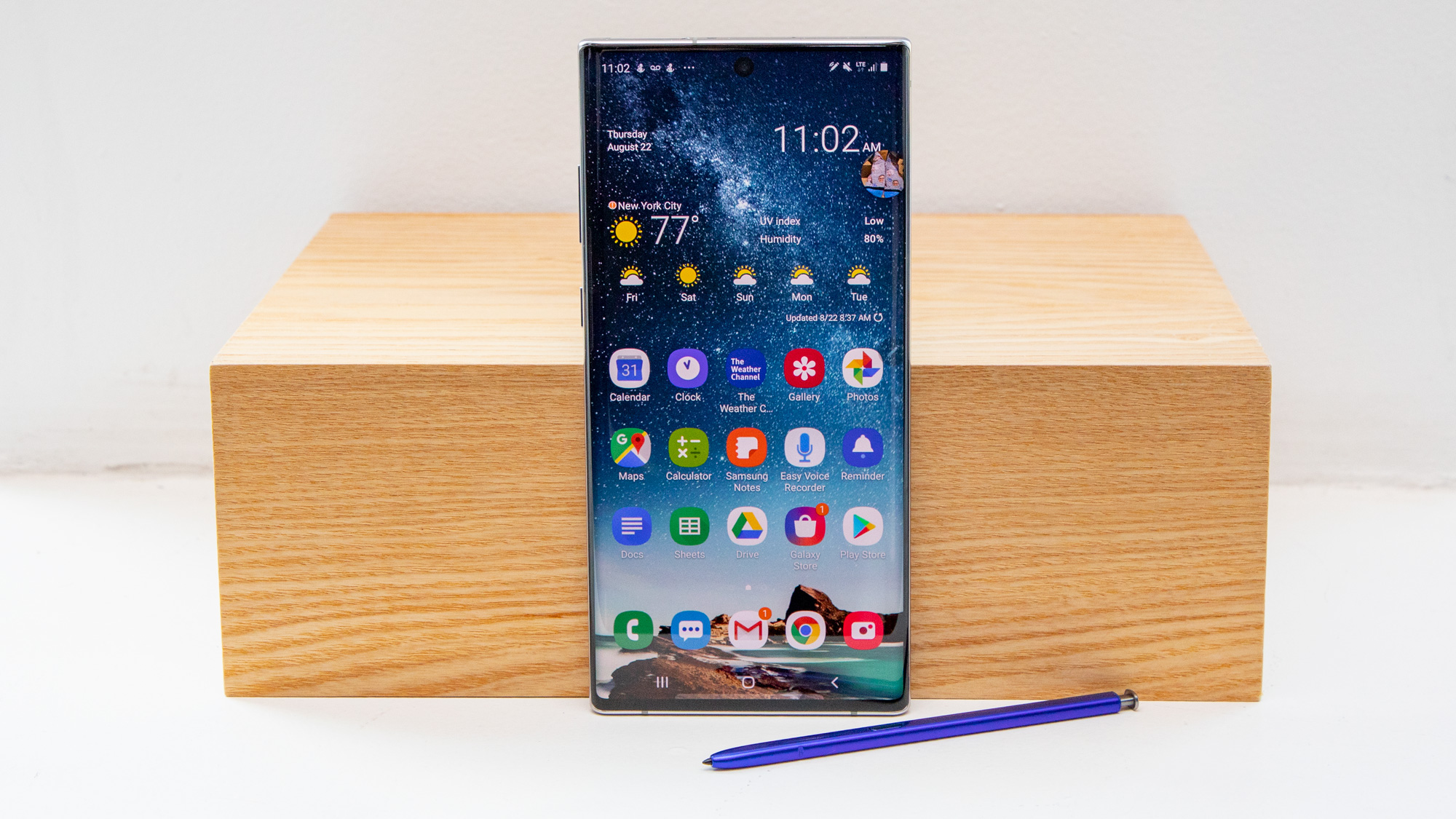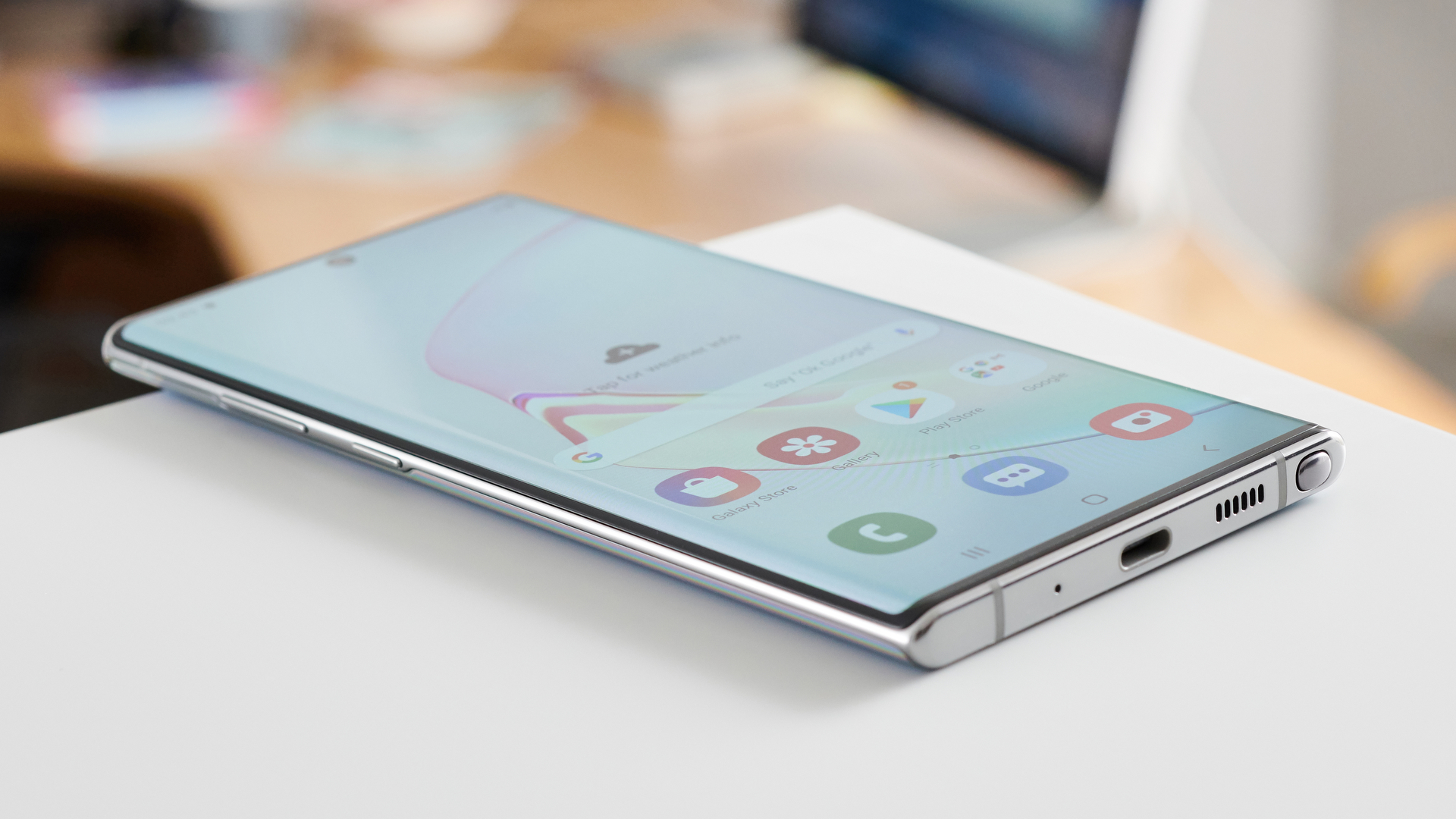Huawei Mate 30 Pro vs Samsung Galaxy Note 10 Plus
Phablet face-off

Huawei's second flagship range for 2019 has now landed in the form of the Huawei Mate 30 and Huawei Mate 30 Pro, and they’re positioned as direct competitors to Samsung’s second flagship range of the year, consisting of the Galaxy Note 10 and Samsung Galaxy Note 10 Plus.
The highlight of the ranges are clearly the Huawei Mate 30 Pro and Galaxy Note 10 Plus, and they have a lot in common, as they’re both top-end phablets.
But they also have a lot of differences, so to help you choose between these two powerhouses, we’ve compared them across all the areas that matter.
Huawei Mate 30 Pro vs Samsung Galaxy Note 10 Plus design

The Huawei Mate 30 Pro and Samsung Galaxy Note 10 Plus both have a curved screen, a metal frame and a glass back. The pair are equally rated for water and dust resistance, with an IP68 rating.
However, there are some key differences. For one, the Mate 30 Pro has a large notch above the screen, while the Galaxy Note 10 Plus opts for a punch-hole camera.
Around the back meanwhile the Huawei Mate 30 Pro’s cameras are arranged in a circular block at the top center, while the Note 10 Plus has its cameras in an oblong arrangement on the top left section. It's mostly up to your aesthetic preference, as neither arrangement noticeably affects the photography.

Perhaps the biggest design difference though is that in the Huawei Mate 30 Pro’s case you don’t have to get it with a glass back at all. The standard models come with a glass back in Classic Black, Space Silver, Cosmic Purple or Emerald Green, but you can also get a vegan leather version in Orange or Forest Green.
Sign up for breaking news, reviews, opinion, top tech deals, and more.
The Samsung Galaxy Note 10 Plus meanwhile only has a glass option, with color choices of Aura Glow - in a mesmerizing rainbow gradient - and the simpler mono-color hues of Aura White, Aura Black or Aura Blue.
Huawei Mate 30 Pro vs Samsung Galaxy Note 10 Plus display

The Huawei Mate 30 Pro has a 6.53-inch curved OLED screen, which curves at a steep 88-degree angle. There’s a resolution of 1176 x 2400, an aspect ratio of 18.4:9, a pixel density of around 409 pixels per inch, and support for HDR.
The Samsung Galaxy Note 10 Plus meanwhile has a 6.8-inch 1440 x 3040 curved Dynamic AMOLED screen with an aspect ratio of 19:9, 498 pixels per inch and support for HDR10+.
So the Note 10 Plus has a larger display, making it a potentially better bet if you want a real phablet. It’s also higher resolution, but both phones have nearly unblemished all-screen fronts.
Huawei Mate 30 Pro vs Samsung Galaxy Note 10 Plus camera

Cameras are one area where Huawei has really excelled lately, and the Huawei Mate 30 Pro looks to be no exception. It has a 40MP ultra-wide f/1.8 lens, a 40MP wide-angle f/1.6 lens, an 8MP f/2.4 telephoto lens (with 3x optical zoom), and a 3D depth sensing lens. The wide and telephoto lenses also have optical image stabilization (OIS).
The Mate 30 Pro also puts a real focus on video recording, with the capability to record at an insane 7680fps in slow motion. That’s along with 4K time lapse, 4K HDR+ at 60fps, and more.

The Samsung Galaxy Note 10 Plus is no slouch when it comes to photography either. It too has four rear lenses, with a 12MP variable aperture main lens with OIS, a 12MP f/2.1 telephoto lens with 2x optical zoom and OIS, a 16MP f/2.2 ultra-wide lens, and a 3D depth sensor.
For video, you get 2160p at 60fps, HDR10+ support, and a number of other features, such as 'Live Focus Video', which blurs the background behind moving subjects.
As for front-facing cameras, the Huawei Mate 30 Pro has a 32MP f/2.0 one alongside a depth sensor, while the Samsung Galaxy Note 10 Plus has a 10MP f/2.2 one.
We’ll let you know how good the Mate 30 Pro’s cameras actually are once we’ve put the phone through a full review, but on paper they certainly sound impressive. The Galaxy Note 10 Plus meanwhile has a setup that we described in our review as not the best but the most fun.
Huawei Mate 30 Pro vs Samsung Galaxy Note 10 Plus specs and features
The Huawei Mate 30 Pro has a Kirin 990 chipset, 8GB of RAM and 256GB of storage. The Samsung Galaxy Note 10 Plus on the other hand has either a Snapdragon 855 chipset (in the US) or an Exynos 9825 one (elsewhere), paired with 12GB of RAM and either 256GB or 512GB of storage.
So the Note 10 Plus has the RAM and storage edge, but chipset-wise the two should be similar, as those are all top-end processors.

The big difference here is in the software. While the Samsung Galaxy Note 10 Plus runs Android 9, complete with full access to Google’s apps and services, the Mate 30 Pro uses Huawei software based on the open source version of Android 10, and has no access to the Google Play Store or any other Google apps and services. That’s a major mark against it and the single biggest issue it could face.
There are plenty of similarities in the features of these phones though. They both have an in-screen fingerprint scanner for example, and both support stylus input, though this is clearly more of a focus for Samsung.
Huawei Mate 30 Pro vs Samsung Galaxy Note 10 Plus battery
You get a 4,500mAh battery in the Huawei Mate 30 Pro and a 4,300mAh one in the Samsung Galaxy Note 10 Plus. So not only is Huawei’s bigger, but remember it’s got a smaller screen to power.
Huawei promises 40W wired charging, 27W wireless charging, and the ability to use the Mate 30 Pro as a wireless charger for other devices.

The Galaxy Note 10 Plus has the same reverse wireless charging trick, and can charge at up to 45W, but its wireless charging is slower at 15W.
With all that in mind we’re cautiously optimistic about the Huawei Mate 30 Pro’s battery life. The Note 10 Plus meanwhile we found to have a battery that would last more than a day, which is good but not great.
Huawei Mate 30 Pro vs Samsung Galaxy Note 10 Plus price and availability
Along with the software issues, availability is a major problem for the Huawei Mate 30 Pro, as there’s basically no chance that it will launch in the US. We’re currently unsure whether it will launch in the UK. though it is coming to Australia. Contrast that with the Samsung Galaxy Note 10 Plus, which is available virtually everywhere.
As for pricing, the Huawei Mate 30 Pro costs €1099 (around $1,200, £970, AU$1,700), though there’s also a Huawei Mate 30 Pro 5G, which comes in at €1199 (roughly $1,300, £1,060, AU$1,900). In both cases you can only get it with 256GB of storage.
The Samsung Galaxy Note 10 Plus on the other hand costs $1,099 / £999 / AU$1,699 for a 256GB model or $1,199 for a 512GB version, which is currently exclusive to the US. Or you can get the Galaxy Note 10 Plus 5G starting at $1,299 / £1,099 / AU$1,999. Pricing then for the two phones is very similar.

Takeaway
The Huawei Mate 30 Pro could prove a hard sell for a lot of people – both because it could prove hard to actually buy in many places, and because the lack of Google services will put many off. That aside, it looks to be a real flagship, with the sorts of specs and features that could make it a true rival for the Samsung Galaxy Note 10 Plus.
The Mate 30 Pro has a bigger battery, faster charging, similar core specs and a steeply curved screen, giving it a striking appearance, but the Note 10 Plus has a larger, sharper display, plus more RAM. Were it not for the software situation, Samsung might have a real fight on its hands.
- These are the best Android apps - but the Mate 30 Pro will lack a lot of them
James is a freelance phones, tablets and wearables writer and sub-editor at TechRadar. He has a love for everything ‘smart’, from watches to lights, and can often be found arguing with AI assistants or drowning in the latest apps. James also contributes to 3G.co.uk, 4G.co.uk and 5G.co.uk and has written for T3, Digital Camera World, Clarity Media and others, with work on the web, in print and on TV.